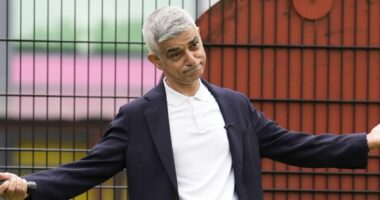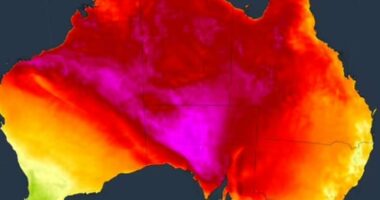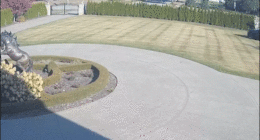Share this @internewscast.com
A young Australian man who passed away under mysterious circumstances in Bali had been partying with two unidentified women just hours before his body was found in a pool, the Daily Mail has revealed.
Byron Haddow, 23, from the Sunshine Coast, was found unconscious inside his private villa on May 26 while holidaying in North Kuta with a friend.
For the last four months, his grieving parents have sought answers from Indonesian authorities regarding their son’s death and its investigation, particularly after his body was sent back without his heart due to a mishandled autopsy.
The family has called the FIFO worker’s death ‘highly suspicious,’ and although his death certificate states he drowned, a Bali coroner discovered he had ingested a deadly mix of alcohol and an antidepressant.
Recently, new information has emerged about the early police investigation and interviews with witnesses. However, the details – found in a police report obtained exclusively by the Daily Mail – have raised more questions than they have answered.
The report contains contradictory testimony, including regarding who discovered Mr Haddow’s body.
According to one witness, three friends were reportedly present when Mr Haddow was found dead.
Irvan Awaludin, the manager of The Grove Bumbak Villa, informed local police that Mr. Haddow and his villa companion, Bailey Woods, were visited by two women just hours before the incident occurred.

Byron Haddow, 23, from the Sunshine Coast, died in Bali in May this year

Exclusive photos show authorities at the Bali villa after the tragic discovery in May

Doctors were called to the villa after Mr Haddow was found unconscious in a pool
Mr. Awaludin was among four witnesses – including Mr. Haddow’s friend Darren Cross, villa supervisor Wayan Agus Ariana, and forensic expert Dr. Nola Margaret Gunawan – who provided critical details to the authorities about the case.
According to Bali Police Spokesperson Senior Commander Ariasandy, Mr Awaludin rushed to the villa about 11.45am on Monday, May 26 after learning of Mr Haddow’s death.
Mr Awaludin said he arrived to find four medical personnel – a doctor, two nurses, and a driver – and Mr Haddow’s body lying face-up on a table, shirtless, wearing only shorts.
Mr Awaludin said he quickly called Mr Haddow’s villa mate, Mr Woods, who was out at the time, and asked him to return to the holiday home as they needed Mr Haddow’s passport. It is not suggested that Mr Woods was in any way involved in Mr Haddow’s death.
Commander Ariasandy said Mr Woods arrived back at the villa around 12.40pm and told Mr Awaludin two women had visited the villa the night before.
‘Bailey told Irvan [that on the morning of Mr Haddow’s death] two foreign women came downstairs from the upper floor of the villa. They screamed hysterically upon seeing the incident, causing a panic,’ Commander Ariasandy said.
Commander Ariasandy said CCTV footage showed Mr Woods and the two women leaving the villa at 10am that morning.
‘Not long after, Bailey went to the Asia Pacific Medical Clinic to seek help,’ he said.

Mr Haddow had been staying at The Grove Bumbak Villa (pictured) with a friend

Two women were reportedly partying with Mr Haddow at the villa the night before he died
‘Based on the villa’s CCTV footage, medical team from the Asia Pacific Medical Clinic were seen entering the villa at 10.03 am, shortly after Bailey had entered [the clinic].’
Mr Awaludin said he did not know the identities of the women, but Mr Woods said the pair were from Melbourne and they were friends of his and Mr Haddow.
Shortly after learning about the fatality, Mr Awaludin called the villa’s supervisor, Mr Ariana, and asked him to come into work.
Mr Ariana said he arrived to find Mr Awaludin and medical staff surrounding Mr Haddow’s body, which had no visible wounds.
Mr Ariana told police he overheard Mr Awaludin and the medics talking about how they believed the Australian’s cause of death was drowning.
Mr Haddow’s body was taken to the Darma Yadna Hospital’s morgue, while Mr Awaludin accompanied Mr Woods to the BIMC Hospital to collect Mr Haddow’s death certificate.
Mr Awaludin told police Mr Woods, along with the housekeeping team, returned to the villa the following day to collect Mr Haddow’s belongings, along with the women’s clothing that was also found inside the room.
In another interview, Darren Cross, 48, from Gympie in Queensland, told Bali Police he read a Facebook post by Mr Haddow’s uncle on May 28, explaining that his nephew had passed away.

Mr Haddow is pictured with his mother, Chantal, who has been calling for answers over her son’s death

Mr Haddow’s body was taken to a hospital morgue before he underwent an autopsy four days later
Mr Cross told authorities he immediately reached out to Mr Haddow’s uncle to offer assistance because he was also in Bali.
Mr Cross said he then got into contact with Mr Haddow’s mother, Chantel, and father, Robert.
However, according to Mr Cross’ account, Mr Woods told Mr Haddow’s family that the two women had left the villa before the 23-year-old was found dead.
‘Cross explained that based on Bailey’s story to Chantel Haddow, that on the night before Byron was found dead in the morning, Bailey and Byron went out from the villa and with two women,’ Snr. Cmr. Ariasandy said.
‘Bailey told Chantel that when they back to the villa, all of them (four people) had been drinking alcohol in the villa near the pool.
‘Bailey told Chantel that Bailey went to sleep earlier, and left Byron with the two woman there near the pool.
‘And when Bailey woke up in the morning at 10am, he found out that Byron had been floating in the pool. And the two women who were with Byron has gone.’
Forensic specialist Dr Nola Margaret Gunawan was interviewed as an expert witness after she carried out an autopsy on Mr Haddow.

Mr Haddow was a FIFO worker from Queensland
Dr Gunawan said Mr Haddow’s body was taken to the mortuary department at Ngoerah Hospital at 8pm on May 30 – four days after his death.
According to the autopsy, Mr Haddow showed signs of blunt force trauma, intoxication, and drowning.
However, Dr Gunawan said she believes his ‘high concentration of alcohol’ combined with the consumption of antidepressant drug, Duloxetine, is what ultimately killed him.
Dr Gunawan said Mr Haddow had ‘bruising on the left forehead, right eyelid, and right knee’ and ‘abrasions on the right eyelid and the dorsum of the right foot’ which were all consistent with blunt force trauma.
‘The blunt force trauma to the individual’s head was not fatal in nature,’ she said, as detailed in the report.
‘However, considering the level of alcohol in the body (along with the potential synergistic interaction with duloxetine), the head trauma could have further contributed to the individual’s physical weakness.’
Dr Gunawan said Mr Haddow had crystals and fungal elements in his lung, indicating that he was still breathing while in the water, but his high alcohol level could have rendered him incapable of getting out of the pool.
Aside from alcohol and Duloxetine, Dr Gunawan said Heneicosane and Hentriacontane (a substance typically found in cosmestics or topical treatments) were also found in his body.

Mr Haddow shared the above photo on Instagram in May during his fateful last trip to Indonesia
‘Duloxetine is a type of psychotropic drug commonly used as an antidepressant, anxiolytic (anti-anxiety medication), and for the treatment of chronic pain and severe muscle pain,’ she said.
‘If Duloxetine and ethanol are consumed together, simultaneously, or shortly before consuming alcohol, the effects of this combination are generally not recommended.
‘I conclude that the most probable cause of death is ethanol intoxication. This is supported by the presence of a large amount of ethanol in all the samples taken, coupled with the presence of duloxetine (although its concentration could not be determined), which significantly increases the likelihood of central nervous system depression as well as impaired judgment and cognition.’
As investigations continue, Bali police have sought the assistance of the Australian Federal Police and the Australian consulate to summon the two female friends so they can speak to authorities.
On Wednesday, a lawyer for the Haddow family released a statement maintaining that Mr Haddow’s death is ‘highly suspicious’ and warrants further investigation.
‘The authorities only followed up on this incident on May 30, 2025, four days after the victim’s death, and even then, only after strong pressure from our Client,’ Malekat Hukum Law Firm said.
‘At present, the police have stated they require assistance from the Australian Consulate to secure statements from these three witnesses. However, it is deeply concerning that, to date, the Consulate has not provided any response.’
News of Mr Haddow’s death first hit headlines in May this year when his family launched a GoFundMe page to help raise money to bring him home.

Chantal Haddow believes her son’s death is ‘highly suspicious’
Earlier this month it was revealed that when his body returned to Australia four weeks after his death, a Queensland pathologist conducting a second autopsy discovered he was missing his heart.
The initial forensic autopsy was performed at the request of Mr Haddow’s family, who suspected foul play, as well as Bali police.
Forensic autopsies seek to identify the cause and manner of death for legal proceedings in suspicious, violent or unexplained cases.
During these kinds of autopsies, it is common for doctors to remove vital organs like the heart or brain for further study.
Mr Haddow’s heart was returned to Australia on August 11 after he had already had his funeral.
His parents were required to pay an additional $700 to have it repatriated.
The death is now the subject of an open coronial investigation, but The Coroners Court of Queensland has not yet released any information regarding its findings.
Malekat Hukum Law Firm said the organ returned is undergoing DNA testing to confirm it is, indeed, the 23-year-old’s heart.
‘Our Clients have not only suffered the loss of their son but have also endured violations of their rights as next-of-kin’ they said on Wednesday.
‘They are entitled to know the truth, to receive honest explanations, and to have their son treated with dignity and respect. This incident raises serious questions regarding medical practices in Bali.
‘What happened to Byron Haddow is a grave matter of law, ethics, and humanity. Our Clients will continue to pursue justice until the truth is fully uncovered.’
















